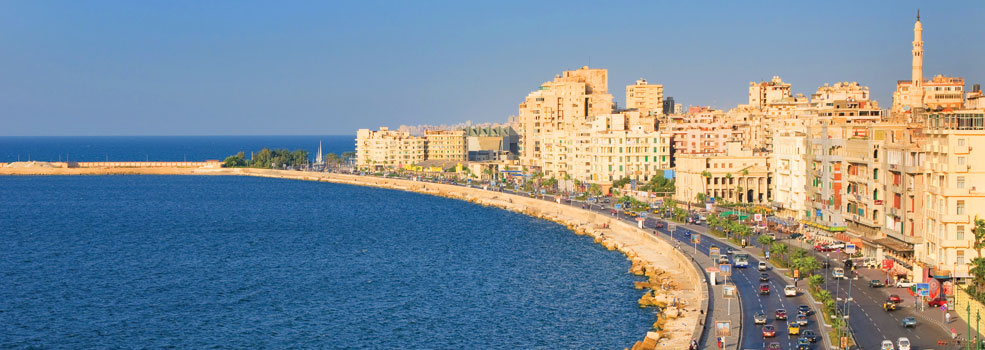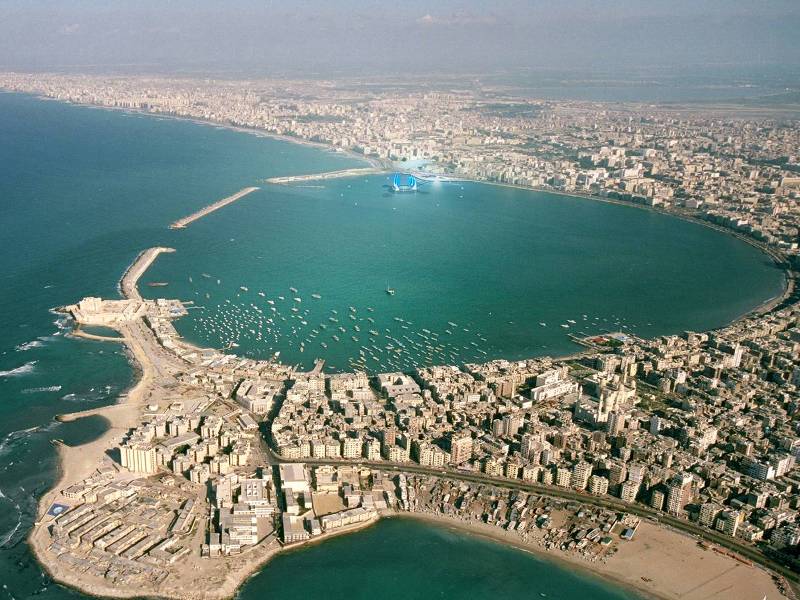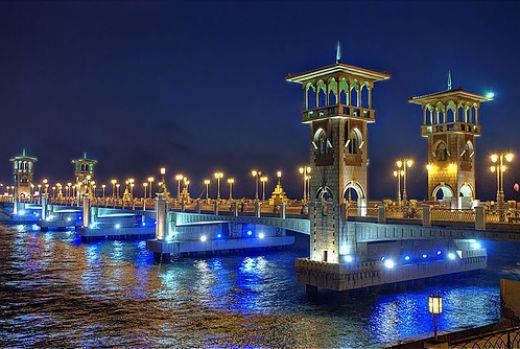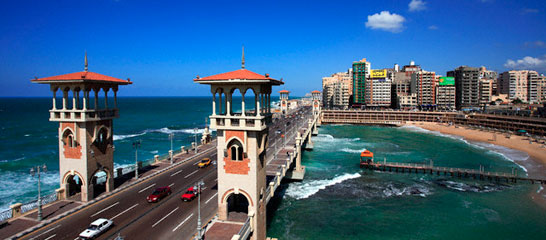Alexandria is the second largest city and a major economic centre in Egypt, extending about 32 km (20 mi) along the coast of the Mediterranean Sea in the north central part of the country. It is also the largest city lying directly on the Mediterranean coast. Alexandria is Egypt's largest seaport, serving approximately 80% of Egypt's imports and exports. It is an important industrial center because of its natural gas and oil pipelines from Suez. Alexandria is also an important tourist resort.
Alexandria was founded around a small Ancient Egyptian town c. 331 BC by Alexander the Great. It became an important center of the Hellenistic civilization and remained the capital of Hellenistic and Roman & Byzantine Egypt for almost 1000 years until the Muslim conquest of Egypt in AD 641, when a new capital was founded at Fustat (later absorbed into Cairo). Hellenistic Alexandria was best known for the Lighthouse of Alexandria (Pharos), one of the Seven Wonders of the Ancient World; its Great Library (the largest in the ancient world; now replaced by a modern one); and the Necropolis, one of the Seven Wonders of the Middle Ages. Ongoing maritime archaeology in the harbor of Alexandria, which began in 1994, is revealing details of Alexandria both before the arrival of Alexander, when a city named Rhacotis existed there, and during the Ptolemaic dynasty.
From the late 18th century, Alexandria became a major center of the international shipping industry and one of the most important trading centers in the world, both because it profited from the easy overland connection between the Mediterranean Sea and the Red Sea, and the lucrative trade in Egyptian cotton. Alexandria was the second most powerful city of the ancient world after Rome.
Alexandria is located in the country of Egypt, on the southern coast of the Mediterranean.
Antiquities
Persistent efforts have been made to explore the antiquities of Alexandria. Encouragement and help have been given by the local Archaeological Society, and by many individuals, notably Greeks proud of a city which is one of the glories of their national history. Excavations were performed in the city by Greeks seeking the tomb of Alexander the Great without success. The past and present directors of the museum have been enabled from time to time to carry out systematic excavations whenever opportunity is offered; D. G. Hogarth made tentative researches on behalf of the Egypt Exploration Fund and the Society for the Promotion of Hellenic Studies in 1895; and a German expedition worked for two years (1898–1899). But two difficulties face the would-be excavator in Alexandria: lack of space for excavation and the underwater location of some areas of interest.
Since the great and growing modern city stands immediately over the ancient one, it is almost impossible to find any considerable space in which to dig, except at enormous cost. Cleopatra VII's royal quarters were inundated by earthquakes and tidal waves, leading to gradual subsidence in the 4th century AD. This underwater section, containing many of the most interesting sections of the Hellenistic city, including the palace quarter, was explored in 1992 and is still being extensively investigated by the French underwater archaeologist Franck Goddio and his team. It raised a noted head of Caesarion. These are being opened up to tourists, to some controversy. The spaces that are most open are the low grounds to northeast and southwest, where it is practically impossible to get below the Roman strata.
The most important results were those achieved by Dr. G. Botti, late director of the museum, in the neighborhood of “Pompey's Pillar”, where there is a good deal of open ground. Here, substructures of a large building or group of buildings have been exposed, which are perhaps part of the Serapeum. Nearby, immense catacombs and columbaria have been opened which may have been appendages of the temple. These contain one very remarkable vault with curious painted reliefs, now artificially lit and open to visitors.
The objects found in these researches are in the museum, the most notable being a great basalt bull, probably once an object of cult in the Serapeum. Other catacombs and tombs have been opened in Kom al-Shoqqafa (Roman) and Ras al-Tiin (painted).
The German excavation team found remains of a Ptolemaic colonnade and streets in the north-east of the city, but little else. Hogarth explored part of an immense brick structure under the mound of Kom al-Dikka, which may have been part of the Paneum, the Mausolea, or a Roman fortress.
The making of the new foreshore led to the dredging up of remains of the Patriarchal Church; and the foundations of modern buildings are seldom laid without some objects of antiquity being discovered. The wealth underground is doubtlessly immense; but despite all efforts, there is not much for antiquarians to see in Alexandria outside the museum and the neighborhood of “Pompey's Pillar”.













